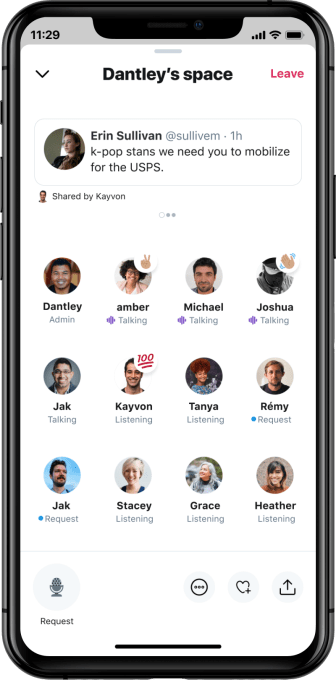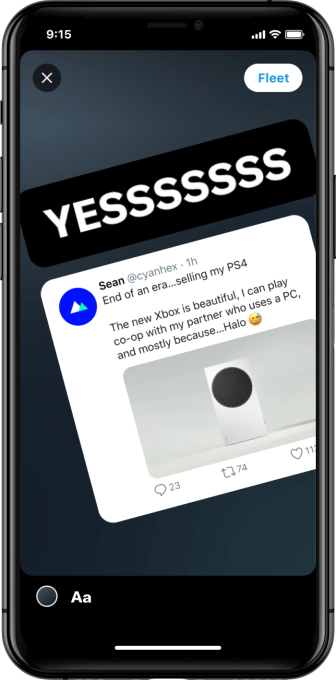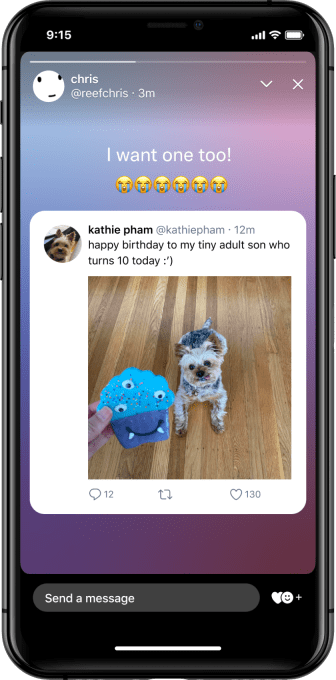Twitter this morning is launching its own version of Stories — aka “Fleets” — to its global user base. The product, which allows users to post ephemeral content that disappears in 24 hours, had already rolled out to select markets including Brazil, India, Italy, South Korea, and most recently, Japan. The company, in a press briefing on Monday, also revealed its plans to test an audio-based social networking feature similar to the controversial app Clubhouse.
Like Clubhouse, Twitter’s new audio spaces will allow people to gather for live conversations with another person or a group of people.
This is an area that, so far, has faced significant moderation challenges due to the nature of live audio. Clubhouse, though still in a private, invite-only testing phase, has already seen several high-profile incidents of moderation failure, including the harassment of a New York Times reporter, and another conversation that delved into antisemitism.
Twitter, for all its efforts at developing new features to combat online abuse — from its Hide Replies feature to its newer conversation controls — has not yet proven itself to be the sort of company that has managed to successfully combat online abuse, harassment, and trolling. Nor has it managed to develop a robust reporting system where users feel their complaints are swiftly handled.
So, given that live audio has proven even more difficult to moderate than text-based posts, Twitter’s decision to invest in this space will likely be criticized by those who don’t believe Twitter can safely engineer a platform for this type of conversation.

Image Credits: Twitter
For what it’s worth, Twitter is not rolling out live audio spaces to all users at once. Instead, it’s first testing the product with a small group of people who the company believes can provide better user feedback than those on Clubhouse’s VC chat room, for instance.
“It’s critical that we get safety right — safety and people feeling comfortable in these spaces. We need to get that right in order for people to leverage live audio spaces in the ways we might imagine or in the ways that would be most helpful for them,” explained Twitter Staff Product Designer, Maya Gold Patterson, when introducing the feature in a briefing for reporters.
“So we’re going to do something a little different,” she continued. “We are going to launch this first experiment of spaces to a very small group of people — a group of people who are disproportionately impacted by abuse and harm on the platform: women and those from marginalized backgrounds,” she added.

Image Credits: Twitter
As to why Twitter felt the need to jump on the audio bandwagon so early in the game, when it’s arriving several years late to the Stories format is less clear.
According to Twitter Director of Design Joshua Harris, the company’s delay to launch Stories was because Twitter was being “methodical in exploring how the format works for people on Twitter.”
That’s not exactly true. Twitter wasn’t years late because it was being careful about Fleets’ development. The reality was that Twitter had prioritized work on its core product over new features.
That’s been changing in recent months, thanks in part to activist investor Elliott Management Group, which took a sizable stake in Twitter earlier this year. It did so with a plan to push the company for more innovation and new executive leadership. (The company later struck a deal to spare Twitter CEO Jack Dorsey’s ousting, however.)
At the time of Elliott’s campaign, Twitter’s lack of Stories had been referenced as an area where the company had fallen behind social media rivals in terms of innovation.

Image Credits: Twitter
Twitter’s trial launch of Fleets soon followed this shakeup. This intervention could also explain why the company is now rushing to enter the still unproven space of audio-based social networking.
Of course, Twitter is aware of the Clubhouse comparisons with its test of audio spaces.
“We think it’s we think that audio is definitely having a resurgence right now across many digital spaces,” noted Twitter Product Lead, Kayvon Beykour. “So it’ll be fascinating to see how other platforms explore the area as well, but we think it’s a critical one for us, too,” he said.
As for Fleets, there’s no change to the product beyond its global availability.

The feature itself is a fairly basic version of the basic Stories format which will be located at the top of the Twitter timeline. Users can post text, photos and videos to Fleets directly, or share tweets into Fleets and post their reactions. Others reply to Fleets via direct messages (DMs), much like how Stories work on other platforms. Twitter says more formats and creative tools will come to the product in the near future.
Twitter also says it’s working to bring standard voice tweets to Android and will make transcriptions for these tweets and other media available in 2021. It’s now testing audio in DMs in Brazil, as well.
The company additionally hinted at some new features in development aimed at pushing Twitter users to be more thoughtful and kinder to one another. These may include built-in reminders and nudges, including ways for friends to reach out privately to another user when they see something is going wrong.
“We’re exploring methods of private feedback on the platform, as well as private apologies, and forgiveness,” said Twitter Senior Product Manager Christine Su. “And so that may look like a notification — that’s like a gentle elbowing from someone that you follow. Or it also may look like a nudge like you’ve seen before.” No further details were provided, nor a timeframe for a rollout.
In the meantime, Fleets will be available to all markets where it hadn’t yet rolled out starting today. The audio spaces test is poised to launch to small groups of users soon.
from Social – TechCrunch https://ift.tt/3kDt7GN Twitter rolls out Stories, aka ‘Fleets,’ to all users; will also test a Clubhouse rival Sarah Perez https://ift.tt/32QVWJR
via IFTTT













0 comments
Post a Comment